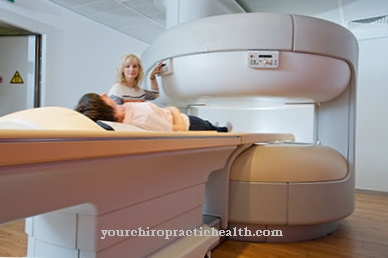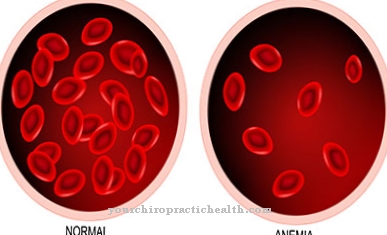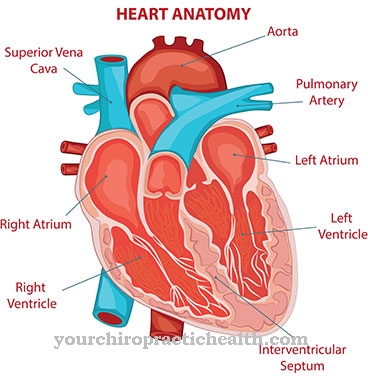In the maxillary retrognathy the upper jaw is underdeveloped and the normally developed lower jaw is beyond it. The phenomenon is an abnormality of the jaw-skull relationship and can occur in the context of hereditary malformation syndromes or in an acquired form after trauma. Treatment of the patient corresponds to a special form of osteotomy.
What is maxillary retrognathy?

© Anna - stock.adobe.com
Prognathies are orthodontic malpositions in which the upper jaw is too far forward in relation to the base of the skull. Misaligned teeth with front teeth of the upper jaw that are too far forward are sometimes referred to as prognathy. The maxillary retrognathy is also known as false progeny denotes and corresponds to a hypoplasia of the upper jaw. Medicine understands hypoplasia to be an underdevelopment.
The underdeveloped upper jaw of the patient falsely leads to the impression of a prognathic condition. The phenomenon is also called Opisthognathy, maxillary retrognathism and maxillary retrognathia designated. The underdevelopment of the upper jaw usually corresponds to a shortening. For this reason, the normally developed lower jaw protrudes beyond the underdeveloped upper jaw part.
Maxillary retrognathy is one of the anomalies of the jaw-skull relationship. The appearance is often based on a hereditary basis. However, maxillary retrognathia can also be acquired in certain circumstances. The phenomenon is the second most common dysgnathia. Defects in the teeth and jaw are summarized as such.
causes
In most cases, maxillary retrognathia is hereditary. In this context, the phenomenon can be present, for example, in the context of syndromes such as Crouzon's syndrome and can be traced back to the primary cause of a genetic mutation. In congenital cases, the hypoplasia of the upper jaw corresponds to an inhibition of growth.
Maxillary retrognathia occur, for example, in the context of a craniofacial dysostosis as craniofacial malformations or and associate the symptoms of acrocephalosyndactyly. The rethrognathy can, however, also be acquired and in this context occur, for example, after operations. Occasionally the most common occurrence of a cleft lip and palate after surgical interventions occurs in childhood.
If teeth are extracted from a patient during childhood or if the patient irreversibly loses teeth of the upper jaw in some other way, this loss, too, can favor acquired maxillary retrognathy. Apart from those with inherited disease, most patients with maxillary retrognathy are completely healthy apart from the anomaly of the upper jaw.
Acquired forms may be preceded by trauma to the jaw or skull that was not adequately treated. In this context, the phenomenon is a local complication.
Symptoms, ailments & signs
Patients with maxillary retrognathy suffer from an abnormal relationship between the jaw and base of the skull. Compared to the upper jaw, the patient's chin is in large part too far forward. Because of this, the patients have a concave facial profile. The faulty development makes the nose and the nasolabial fold extremely prominent.
Often, the patients complain of difficulty breathing through the nose with accompanying symptoms, since nasal breathing is restricted by the displacement of the jaw. Which additional symptoms are present depends on the cause of the maxillary retrognathy. In the context of malformation syndromes, there are usually many other malformations of the craniofacial system.
In acquired cases, the anomaly is usually an isolated phenomenon. Under certain circumstances, the undesirable development can be associated with pain, especially with traumatic causes. Problems with eating or drinking can arise from a certain level. In addition, all misalignments and incorrect loading of the jaw can cause complaints such as headaches or tension.
Diagnosis & course of disease
As part of the diagnosis, maxillary retrognathia must be distinguished from mandibular prognathia. With these undesirable developments, there is no shortened upper jaw, but an elongated lower jaw that protrudes beyond the upper jaw. The maxillary retrognathy at first glance gives the appearance of a prognathy, but in no way corresponds to the same anomaly. The diagnosis is made by the dentist or oral surgeon. In most cases the prognosis is excellent. That is true at least after early diagnosis of the anomaly.
Complications
With this disease, those affected usually suffer from various complaints in the area of the jaw. This leads to changes and deformations in the face, so that those affected primarily suffer from limited aesthetics. Children in particular can also suffer from bullying or teasing.
It is not uncommon for this to lead to a greatly reduced self-esteem or even to inferiority complexes. Sometimes the disease also leads to breathing difficulties, so that in the worst case, patients can also lose consciousness. The internal organs are also supplied with less oxygen.
Malformations can also occur in the face. The disease also leads to tension in the neck and jaw and not infrequently to headaches. Misalignments can also occur. Ingesting food and fluids can be difficult.
Treatment of this disease is carried out with the help of various interventions. As a rule, there are no particular complications. Many misalignments and complaints can be corrected in this way. The patient's life expectancy is usually not reduced by the disease.
When should you go to the doctor?
People who suffer from an optical change in the shape of their face should consult a doctor. In particular, if the upper and lower jaws are not on top of each other, there is cause for concern and it could be an indication of maxillary retrognathy. If there is a significant overbite, a visit to the doctor is advisable so that the jaw can be corrected. If problems with food intake develop due to the deformities, a doctor should be consulted. If food cannot be properly chewed due to the discomfort, it is advisable to consult a doctor. If you refuse to eat or if you only consume liquid or pulpy foods, a doctor's visit is necessary.
In many patients, the normal breathing activity is impaired due to the malformations. A doctor is required if breathing becomes difficult, if this leads to sleep disorders or if fears arise due to the shortage of breath. If you have headaches, muscle problems or tension in the shoulder and neck area, see a doctor. If the person concerned also suffers from a mental disorder, a doctor should also be visited. Medical and therapeutic help is required in the event of social withdrawal, a depressed mood or behavioral problems. If you have low self-confidence, a reduced zest for life or a significant loss of well-being, a doctor's visit is necessary.
Treatment & Therapy
Patients with maxillary retrognathy must be treated as early as possible. If left untreated, the abnormality of the jaw can cause serious damage to the teeth and the supporting structure. It is important to avoid these complications by means of early treatment. The treatment is mostly causal and takes place under orthodontic care. There are no conservative treatment options for the phenomenon.
Operative procedures are to be given priority. The oral surgeon usually resolves the malformation as part of a special osteotomy. Osteotomies are surgical procedures for the targeted severing of bones that can correct misalignments. In this context, a so-called corrective osteotomy is often used. An osteotomy is followed by an osteosynthesis, in which the severed bones are brought into position and fixed.
In patients with maxillary retrognathy, osteotomy and osteosynthesis serve to shift the upper jaw forward. In this case, the operation is preferably performed using the Le Fort I osteotomy technique. In most cases, the operation can correct the anomaly at least to the extent that complications such as tooth damage or damage to the holding apparatus are excluded.
You can find your medication here
➔ Medicines for painOutlook & forecast
The positive prognosis for maxillary retrognathy applies in most cases. However, the condition for this is early diagnosis. The shortening of the lower jaw can be hereditary. However, it can also arise from other circumstances, for example trauma to the face. Maxillary retrognathy must be differentiated from a normal underbite. This is caused by a too far protruding upper jaw.
As a result of maxillary retrognathy, those affected suffer from an unusual appearance. They have malformations of the head and numerous complaints. You may experience difficulty breathing. Maxillary retrognathy has no impact on lifespan. However, it can reduce the quality of life. This is especially true when it is difficult to eat or breathing. Aesthetic questions are also touched upon by maxillary retrognathy.
Orthodontic treatment for maxillary retrognathy is essential. It can usually be ended with good results. The facial and jaw malformations that occur in maxillary retrognathy usually have to be corrected by maxillary surgery. The ability to chew, unhindered breathing and a more appealing appearance must be ensured.
Psychological sequelae such as inferiority complexes or depression are common. If they are given psychotherapeutic treatment, the overall prognosis is good. This is especially true if there is a prospect of oral surgery to improve the situation.
prevention
A maxillary retrognathy in the context of malformation syndromes is difficult to prevent. However, acquired anomalies of this kind can be ruled out by performing interventions on the child's jaw or the cleft palate and palate only from a certain age and with the necessary pre- and post-operative care.
Aftercare
The treatment of the jaw misalignment or tooth misalignment by the orthodontist can in some cases be supplemented with the help of special aftercare. This will be discussed with the treating orthodontist. This must be decided on a case-by-case basis. The cause of the misalignment of the jaw and teeth is closely related to the type of follow-up care.
If the teeth are simply unevenly grown, it may be helpful to wear a stabilizer for a certain time after the traditional treatment with braces. This is adjusted by the orthodontist and ensures the result of the treatment in the long term.
You can do that yourself
If maxillary retrognathy is suspected, a doctor or orthodontist should be consulted immediately. Immediate treatment is necessary in order to avoid serious damage to the teeth and the holding apparatus and to ensure a quick recovery overall.
The treatment itself can be supported by those affected by good dental and oral hygiene. By brushing your teeth more and using a medical mouthwash, the risk of inflammation is reduced, especially in the case of existing damage to the periodontium. If there is still no damage, the most important measure is to compensate for the difficult nasal breathing with conscious mouth breathing. This is especially important in the case of severe malformations of the jaw, because a pronounced misalignment can cause severe breathing difficulties and, as a result, a chronic lack of oxygen.
In addition, action must be taken against the individual symptoms. Headaches can be reduced through conscious relaxation and fresh air. Effective remedies from naturopathy include valerian and chamomile. A gentle massage helps to relieve tension in the jaw area. Here, too, conscious relaxation can reduce the discomfort. However, if the symptoms are pronounced, a doctor should be consulted.





.jpg)
.jpg)










.jpg)







.jpg)


